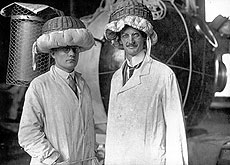Magnificent men in their flying machine

Seventy-five years ago two Swiss wearing wicker baskets stuffed with cushions on their heads made the first manned balloon flight into the stratosphere.
An exhibition featuring film, photos and documents tracking the historic ascent to a record 15,780 metres has opened at the Lake Geneva Museum in Nyon.
“This was the first time anyone had left the earth’s atmosphere and for the time it was an incredible achievement,” curator Jean-François Rubin told swissinfo.
The figure of Basel-born Auguste Piccard was the inspiration for Tintin’s batty Professor Cuthbert Calculus, and seeing pictures of the intrepid explorer alongside his assistant Paul Kipfer, it is easy to see why.
With their rather unconventional headgear, they look like characters out of the film “Those Magnificent Men in Their Flying Machines”. The set-up was a world away from the Breitling Orbiter 3 in which Piccard’s grandson Bertrand made his record-breaking round-the-world trip in 1999.
Having proved Einstein’s theory of relativity in a balloon at 4,500m in June 1926, Piccard, then a professor of physics at the Free University of Brussels, proposed a flight into the upper atmosphere to gather data, as well as to measure cosmic rays.
To do so, he designed a small spherical, pressurised capsule made out of aluminium, which was 2.10m in diameter because “it is the smallest space in which there is room for two observers and a lot of instruments”.
“This was the first ever space capsule. Nasa considers them as the first astronauts,” said Rubin.
The huge 30m-high balloon, made out of two layers of cotton glued together with rubber, was financed by Belgium’s National Fund for Scientific Research – hence the balloon’s name “FNRS”.
Bavarian launch site
Piccard picked the site of Augsburg in Bavaria for the launch as it was near where the balloon was made and a fair distance from the coast, reducing the risk of having to ditch in the sea.
Lift-off was fixed for September 14, 1930, but the flight soon ran into difficulties after the German authorities refused to grant permission for safety reasons. Fortunately for Piccard, who was a member of the Swiss Aero-Club, the Swiss authorities agreed to assume responsibility.
Bad weather torpedoed the initial launch and it was not until the following year that a fresh attempt was made. The balloon was slowly inflated and at 3.53am on the morning of May 27, Piccard and Kipfer rose swiftly into the sky.
But the lift-off was anything but smooth, with the capsule crashing into a truck. The capsule sprung a leak and after making emergency repairs the pair settled down for the rest of their record-breaking flight. Within half an hour of taking off, they had reached 15,780m.
Blocked valve
Their problems were, however, far from over. A rope was blocking a valve, which meant they could not release hydrogen from the balloon and descend – or at least not until the sun started setting and the gas cooled.
Piccard told his assistant: “I have never come across a case where a balloon never descended. The only question is when will we descend?”
It wasn’t until 2pm and after several hours of suffering extremes in temperature and lack of water that the balloon started heading slowly downwards, finally picking up speed around 8pm.
About 17 hours after leaving Augsburg they finally came to rest on a glacier in the Austrian Tyrol where they spent the night wrapped in the balloon. They were picked up by a ski patrol the next day.
And those wicker baskets? “Both of us were protected against knocks on the head by a basket stuffed with a cushion,” noted Piccard.
“During our ascent, the baskets contained several back-up items and the cushions embellished our wicker seats. In case of a sea landing, the cushions, with their kapok filling, would have served as a life-vest.”
swissinfo, Adam Beaumont in Geneva
August Piccard was born in Basel on January 28, 1884.
He worked at the Federal Institute of Technology in Zurich from 1917.
In 1922 the physics professor moved to the Free University of Brussels, where he conceived the FNRS.
He later developed the world’s first bathyscaphe, the FNRS2.
Together with his son Jacques, he built the bathyscaphe, Trieste, which explored the Mariana Trench, setting a new depth record in 1960.

In compliance with the JTI standards
More: SWI swissinfo.ch certified by the Journalism Trust Initiative











You can find an overview of ongoing debates with our journalists here . Please join us!
If you want to start a conversation about a topic raised in this article or want to report factual errors, email us at english@swissinfo.ch.